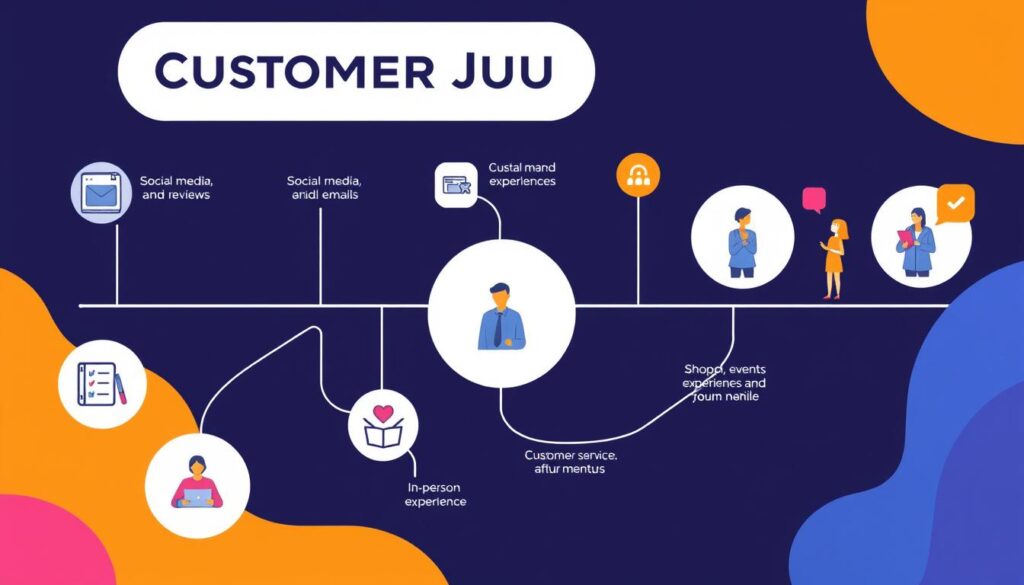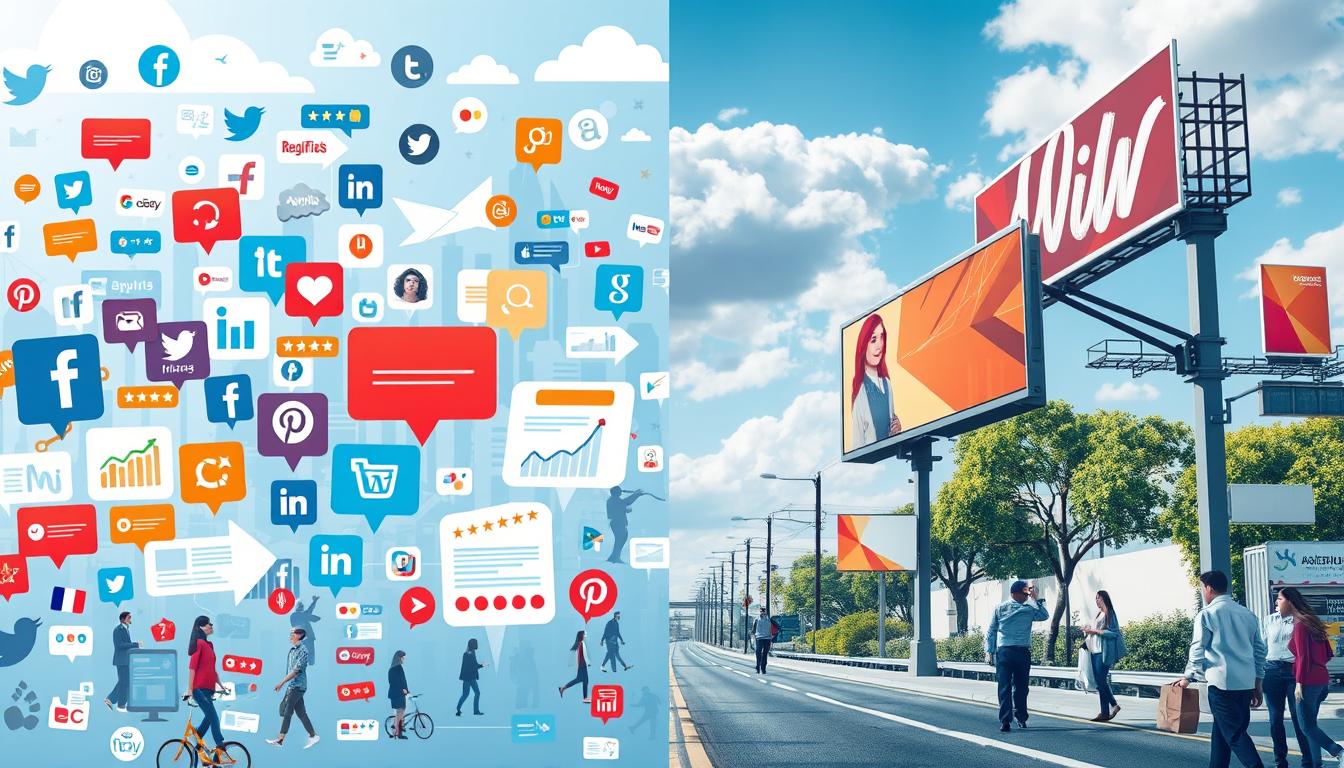In today’s digital world, balancing your online and offline reputation is a big challenge for businesses. They must manage their brand image carefully. Your digital footprint can greatly affect your success, but so do traditional interactions.
The gap between online and offline reputations is getting smaller. With most adults always having their phones nearby1, the digital world is always accessible. This means managing your online reputation is more important than ever.
Did you know 88% of people trust online reviews as much as personal advice1? This shows how powerful digital word-of-mouth is. But, it’s hard to keep your reputation consistent online and offline.
For online businesses, it’s crucial to have great online ratings and positive in-store experiences. It’s not just about your online image. It’s about making sure your brand is consistent from online to in-person.
We will look into the details of managing your reputation online and offline. We’ll find strategies to make sure your brand looks good in every interaction, whether online or in person.
Key Takeaways
- Online and offline reputations are increasingly interconnected
- Digital presence significantly impacts consumer trust and decisions
- Consistency across online and offline channels is crucial
- Mobile connectivity amplifies the importance of online reputation
- Balancing digital and physical brand experiences is key to success
Understanding the Digital Age’s Impact on Reputation
The digital age has changed how we handle brand reputation. Now, our online presence greatly affects how customers see us. Digital marketing focuses on keeping a good online image.
Social media has become key in shaping brand reputation. They let businesses reach people all over the world, build strong bonds, and gain loyal customers. But, they also increase the risk of bad publicity2.
Online reviews have a huge impact. Most people trust them as much as advice from friends. Brands keep an eye on reviews on sites like Yelp, Google My Business, and TripAdvisor to see what people think3.
“In the digital age, your online reputation can make or break your business.”
To manage reputation online, brands should:
- Watch search engine rankings
- Keep track of online reviews and ratings
- Look at social media engagement
- Check website traffic
- Watch brand mentions online4
Being open in business builds trust. This means being honest, quickly solving customer problems, and talking with your audience. Making good content and being active online can fix trust issues with your brand2.
Handling reputation in the digital age means being proactive. Using O2O marketing helps match your online and offline images. This is crucial for a strong brand image in both the digital and real worlds3.
Defining Online Reputation vs. Offline Reputation
In today’s world, we have two reputations: online and offline5. Our online identity comes from our social media, digital content, and how we talk online. It’s a way to show who we are and make smart choices.
Offline reputation is about how we act in person, how we help customers, and how our staff acts in stores. Mistakes here can’t be fixed easily, so they can really matter.
It’s very important to manage both reputations. Most people find local businesses online, showing how big a role digital presence plays6. But, 84% of people trust reviews more than ads, showing the value of meeting people in person6.
| Aspect | Online Reputation | Offline Reputation |
|---|---|---|
| Primary Channels | Social media, websites, review platforms | In-person interactions, physical stores |
| Response Time | Can be carefully considered | Immediate reactions required |
| Editability | Can often be modified or deleted | Difficult to retract or change |
| Impact on Trust | 74% trust businesses more with positive reviews | Direct experiences shape perceptions |
Only 5% of users look past the first page of Google, showing how important online reputation is6. But, we can’t ignore our offline presence. It’s key in making first impressions, forming opinions, and feeling comfortable with a brand5.
To do well in both areas, businesses need to make sure their online and offline images match. This consistency is key to building trust and being seen as real in a world where customers want smooth experiences everywhere.
The Power of Online Reviews and Ratings
In today’s digital world, online reviews and ratings are very powerful. A huge 99.9% of customers look at reviews before buying online, and 96% look for the negative ones7. This shows how important reviews are in making buying decisions.
Review sites like Yelp, TripAdvisor, and Google My Business are where people go to check out products and services. Almost half of all shoppers trust online reviews as much as advice from friends and family7. Young people, aged 18 to 34, also trust online reviews just as much as personal advice7.

Reviews do more than just help people decide what to buy. They can really affect a business’s success. Good reviews can make a company more visible online, bringing in more visitors and increasing sales8. Reviews on social platforms can lead to much higher sales – 5.3 times more on LinkedIn, 8.4 times more on Twitter, and 40 times more on Facebook7.
For businesses, keeping a good online reputation is key. Getting happy customers to share their thoughts can really help a business look good online8. Keeping an eye on review sites helps businesses know what customers think and respond quickly. Being quick to respond is important – 53% of shoppers expect a business to answer negative feedback within a week7.
| Platform | Conversion Rate Increase |
|---|---|
| 5.3x | |
| 8.4x | |
| 40x |
Online reviews aren’t just for products. In the job world, 86% of people check company reviews and ratings before applying for a job7. This shows how crucial a good online reputation is for all parts of a business.
Building Trust and Authenticity Across Channels
In today’s digital world, it’s key for businesses to be trusted and real. Brand values and how customers feel about them greatly shape what people think. In fact, 81% of consumers look at brand trust when deciding what to buy9. This shows how important it is to keep your message and values the same everywhere.
O2O marketing is a strong way to link what you do online with what you do in real life. It blends digital and physical experiences for a smooth customer journey. This method works well, as 85% of people trust online reviews as much as advice from friends10.

Being real is crucial for strong customer bonds. Companies that keep their online and offline experiences consistent do better. Think about it: 32% of customers will leave a brand they love after just one bad experience9. This shows how important it is to keep customers happy at every step.
| Factor | Impact on Business |
|---|---|
| Consistent Brand Presentation | 33% increase in revenue |
| Positive Online Reviews | 10% increase in revenue per star improvement |
| Active Social Media Engagement | 20-40% increase in positive brand sentiment |
To gain trust and be seen as real, businesses should get to know what customers like and offer them unique experiences. By making customer groups and profiles, companies can make a better connection between online and real life. This can bring in 10-15% more customers10. Remember, being consistent pays off – a steady brand image can boost sales by 33%9.
Strategies for Aligning Digital and Physical Personas
In today’s world, it’s key to keep our online and offline images in sync. We do this by being true to ourselves and making thoughtful content everywhere we share it.

Customer segmentation is a big part of this. By understanding what different customers like, we can make our messages hit home. This makes our online and offline content more relevant to everyone.
Content marketing helps bridge the gap between our online and real-life selves. We should plan our content well to make sure it’s consistent everywhere. This keeps our online and offline messages in line, strengthening our brand11.
Mapping out the customer journey shows us where we might be out of sync. By seeing the whole customer experience, we can find areas to improve. This helps us make our brand feel more connected.
“Consistency in integrating online and offline identities is key to building a cohesive and trustworthy professional image.”
Let’s look at how someone does this well. Khushboo Bajaj More, a six-year MDRT member from Mumbai, India, uses different platforms to boost her career. She uses LinkedIn to share her knowledge, connect with others, and offer financial advice12.
| Platform | Purpose | Content Strategy |
|---|---|---|
| Professional networking | Industry insights, collaborations | |
| Quick updates | Financial tips, market trends | |
| Professional Blog | In-depth content | Detailed financial advice, case studies |
| Video Content | Educational material | Retirement planning insights, expert interviews |
Khushboo makes sure her content fits her audience on each platform. This way, she keeps her brand strong across all her interactions12. Her strategy shows how personalizing content can build a solid professional image.
The Role of Social Media in Reputation Management
Social media marketing is key to managing a brand’s image today. Sites like Twitter, Facebook, Instagram, and YouTube are essential for keeping an eye on how people see your brand13. Managing these platforms well can greatly affect a company’s image and profits.
User-generated content is very important for a brand’s online reputation. Good reviews build trust and credibility, helping new customers decide to buy. On the other hand, bad feedback can scare off potential customers14. That’s why it’s crucial to manage and respond to online reviews and mentions.

How fast a brand responds to feedback is key in social media management. Quick and personal replies to both good and bad feedback show you care about customer satisfaction14. Using tools to listen and monitor can give brands insights into what customers think. This helps shape their social media plans15.
| Aspect | Impact on Reputation |
|---|---|
| Positive Reviews | Boost trust and credibility |
| Negative Reviews | Potential damage to brand image |
| Response Time | Demonstrates customer commitment |
| User-Generated Content | Shapes brand perception |
To manage social media well, brands should regularly check their online presence, look at feedback, and use tools like Socialinsider or Sprout Social15. These steps help create a strong brand image online and offline, making the brand more respected overall.
Online Reputation vs. Offline Reputation: Bridging the Gap
Today, it’s key to connect our online and offline reputations. We’ve found four levels of expertise in making an online presence: Beginner, Master of Branding, Traditional Thought Leader, and True Reach Experts16. To do well in both areas, companies need to keep an eye on their reputation and manage crises well.
Local networking is a top way to boost your offline SEO and connect with people in your area17. This method fits well with public relations, helping build a strong local image that also shows up online.
E-commerce is changing how we shop. Mobile commerce sales are set to double in 2013, and online sales of clothes and accessories will hit $224.2 Billion by late 2012, up 15.4% from 201118. This shows how important it is to mix digital tech with what happens in stores.
Influencer marketing is key in linking online and offline reputations. For many companies, over half of their sales come from social selling, with sites like Facebook, Twitter, and LinkedIn helping a lot18. Using these platforms can help make your brand look consistent everywhere.
| Strategy | Online Impact | Offline Impact |
|---|---|---|
| Local Networking | Improved local SEO | Stronger community ties |
| Influencer Partnerships | Increased social media engagement | Enhanced brand credibility |
| Traditional Media Outreach | Broader online visibility | Established local authority |
By using these strategies and staying consistent across all platforms, businesses can link their online and offline reputations well. This makes for a strong and united brand image.
Conclusion
We’ve looked at how online and offline reputations work together today. Online reviews are huge, with 90% of people checking them before they visit a place or buy something19. This shows we need a strong plan to manage our online and offline reputations.
Keeping a consistent brand image is crucial. Online reputation management (ORM) helps improve a brand’s online presence and control how people see it online20. With 84% of people trusting online reviews as much as personal advice21, this digital shift has changed how companies build their reputations.
Putting the customer first is key now. Companies should talk to their audience on all platforms, as 54% of people look up a seller’s website after hearing good things21. By adapting to these changes and using good reputation management, businesses can have a strong brand that connects with customers online and offline.
As we go forward, keeping up with new trends in managing our reputations is crucial for success. The digital age has changed how reputations are made, letting companies shape their image quickly through online mentions21. This fast change means businesses must keep updating their reputation management plans.
FAQ
What is the difference between online and offline reputation?
Why is it important to manage both online and offline reputations?
How do online reviews and ratings impact a business’s reputation?
What strategies can businesses use to align their online and offline reputations?
How can social media be leveraged for effective reputation management?
What techniques can help bridge the gap between online and offline reputations?
Source Links
- Townsquare Interactive | Online vs. Offline Reputation: Which Is More Important? – https://townsquareinteractive.com/blog/online-vs-offline-reputation-which-is-more-important/
- The Importance of Reputation Management in Today’s Digital Age – https://www.smargasy.com/the-importance-of-reputation-management-in-todays-digital-age/
- Online Reputation Vs. Offline Reality: Aligning Your Digital And Physical Persona – https://konnectinsights.com/blogs/online-reputation-vs-offline-reality/
- Online Reputation Management: Building Trust in the Digital Age – https://www.linkedin.com/pulse/online-reputation-management-building-trust-digital-age-thakur-v0hlf
- ‘Do your online & offline reputations support each other’? – https://www.linkedin.com/pulse/does-your-online-offline-reputation-support-each-other-john-r-spence
- Online Reputation Management: How to Protect Your Brand | InMoment – https://inmoment.com/blog/online-reputation-management/
- 17 Online Review Statistics You Need To Know in 2024 – https://trustpulse.com/online-review-statistics/
- The Power of Online Reviews: Managing Reputation in the Digital Age – https://www.linkedin.com/pulse/power-online-reviews-managing-reputation-digital-age-cothm-dubai
- How to Build a Positive Brand Reputation: Key Strategies – https://www.nextiva.com/blog/how-to-build-brand-reputation.html
- How to Build and Maintain a Positive Online Reputation – https://www.reputationsciences.com/how-to-build-and-maintain-a-positive-online-reputation/
- Mastering Your Digital Image: Using OSINT for Online Reputation Management – https://medium.com/@viktor.osint/mastering-your-digital-image-using-osint-for-online-reputation-management-494771ef329c
- Enhancing your offline persona through cultivating an online presence: Tips and strategies – https://www.mdrt.org/learn/2024/html/enhancing-your-offline-persona-through-cultivating-an-online-presence-tips-and-strategies/
- Social Media Reputation Management: Key Considerations – https://www.reputationsciences.com/social-media-reputation-management-considerations/
- Online Reputation vs. Offline Reputation: Bridging the Gap for a Cohesive Brand Image – https://medium.com/@arun.rout/online-reputation-vs-offline-reputation-bridging-the-gap-for-a-cohesive-brand-image-bd84eef2c642
- Social Media Reputation Management | Socialinsider – https://www.socialinsider.io/blog/social-media-reputation-management/
- Unlock Better Reach: Bridge the Gap Between Online and Offline Activities | Jane Friedman – https://janefriedman.com/closing-the-influence-gap/
- Offline SEO: Bridging the Gap Between Online and Local Presence – Databird Business Journal – https://www.databirdjournal.com/posts/offline-seo-bridging-the-gap-between-online-and-local-presence
- Bridging the Gap Between Online and Offline Sales – https://www.moneythumb.com/blog/bridging-the-gap-between-online-and-offline-sales/
- How Does Online Reputation Impact Customer Perception – https://www.retainr.io/blog/how-does-online-reputation-impact-customer-perception
- Online Reputation Management vs. Public Relations: Understanding the 7 Major Differences – https://konnectinsights.com/blogs/online-reputation-management-vs-public-relations/
- Why reputation offline is no longer important – “The Online World is More real than Offline” – https://www.exclusiveprs.com/post/why-reputation-offline-is-no-longer-important-the-online-world-is-more-real-than-offline

